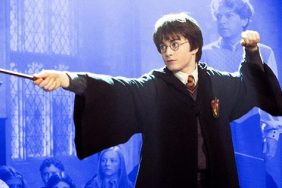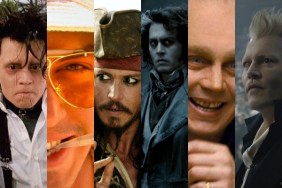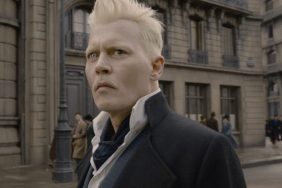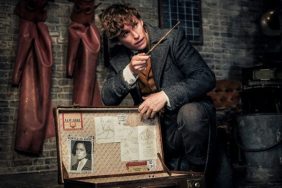If you missed the MTV Movie Awards tonight (and we don’t blame you, since they’re usually just awful), you might have missed a couple of major trailers debuting from Warner Bros., a studio that could use a bit of good buzz right now after Batman v Superman failed to set the world on fire like it was supposed to. One was Suicide Squad (which demanded its own editorial), and the other was Fantastic Beasts and Where to Find Them, a prequel to the beloved Harry Potter movies that – unlike its predecessors – isn’t already based on a hit novel.
Although Fantastic Beasts and Where to Find Them is in many respects a reunion – filmmaker David Yates directed the last four Potter films, J.K. Rowling wrote the story, etc. – it is also a major x-factor in the studio’s line-up. J.K. Rowling wrote the screenplay this time around, but just because she’s an exceptional novelist doesn’t necessarily mean she can write great original script. (Stephen King wrote the screenplay for Sleepwalkers. My point is, nobody’s perfect.)
Also: The Failure of ‘Batman v Superman’ Could Ruin Superhero Movies
The film also shares none of the same characters as the previous Harry Potter movies, which is probably why this new Fantastic Beasts trailer goes out of its way to namecheck Albus Dumbledore as quickly as possible, just to extend a hand across the aisle to all the wary original fans. But that’s not why this new trailer for Fantastic Beasts and Where to Find Them has us so excited. There are three big promises being made here, for a film that could very well live up to the epic franchise from which it sprang, and send it in fascinating new directions.
So here is the trailer…
…and here’s why we think this looks fantastic.
It’s the Next Harry Potter, But It’s Not

Warner Bros.
Yes, that sounds rather obvious since this is yet another film set in the “Harry Potterverse,” but consider that the previous Harry Potter movies were all a chronological progression of a young boy’s path into adulthood. We met Harry Potter when he was just a boy, and we followed him from his first year at school until his last. What we didn’t see is what happened next, and those important steps into the world outside of school.
So what happens next – for audiences at least – is now Fantastic Beasts, a film that is apparently about a youngish man who has left (or in this case, been kicked out of) Hogwarts and who now seeks to make his own way in the world. The next “Harry Potter” movie, if it followed the path of the original series, would have set Harry on a similar journey at a similar time in his life. So this is a natural extension of the franchise, but in all-new surroundings and with all-new characters. What’s old is new and vice-versa, and that’s a very clever way to appeal to fans of the series while transforming the franchise altogether.
It’s About Wizards in the Muggle World

Warner Bros.
The fundamental premise of the Harry Potter stories has always been that of a boy, raised in the normal (“Muggle”) world, escaping into a realm of fantasy. But what we see in this new Fantastic Beasts trailer is a fantastic character hiding in the normal world. We see Newt Scamander entering the country under false pretenses. We see an evidently powerful and/or threatening person, played by Colin Farrell, who appears to be discovering the existence of magic. (He also refers to “humans,” which is unusual in the wizarding world, where everyone is either a “wizard” or a “muggle,” implying he’s not a wizard even though – in a different shot – we see him doing something magical.) We later see Newt Scamander’s roommate, apparently discovering the fantastic for the first time as well.
If that truly is the focus of Fantastic Beasts, then it is essentially an inversion of the Harry Potter stories we have seen before now, a concept that’s less about escapism and now more about secrecy, and possibly even paranoia. That’s thrilling ground on which to build a new type of story within the Potterverse.
It’s a New and Relevant Theme: Immigration

Warner Bros.
We’ve known for a long time that Fantastic Beasts and Where to Find Them was going to take place in America, prior to the events of the other Harry Potter stories. But now we see that it is about traveling to America, from a foreign land, while hiding potentially dangerous threats in your luggage. That’s a point of anxiety for a lot of Americans, and apparently it will now be personified by a larger-than-life hero being marketed to children. That’s pretty intriguing, isn’t it?
Now granted, that’s also a HUGE can of worms, and the film may only focus on it as briefly as we saw in the trailer. Heck, all three of the reasons this trailer excites us may wind up being minor elements of the final motion picture (if they wind up being there at all). But what we have here is a preview, that is to say a promise that the studio is making to fans of this series. These are the elements that they evidently want to assure Harry Potter fans are going to be a part of the future of this series, whether that’s wholly true or not, and one of those elements is apparently going to be immigration.
So we see the influx of the new and foreign into our land, but in the context of wonderment instead of – or at the very least in addition to – fear. Sadly, horrifying xenophobia is very much a part of our shared cultural history, and just as sadly, very much still a part of the sociopolitical conversation today. So this is a downright a daring topic on which to base a potential multibillion dollar family fantasy franchise. The promise that Fantastic Beasts will explore our fears of the outside world, and to establish a mindset of acceptance and appreciation for other cultures by equating them to wonderful wizards, is positively staggering, and staggeringly positive… at least in theory.
Will Fantastic Beasts and Where to Find Them live up to these promises? We’ll have to wait until the film comes out on November 18, 2016 to find out. But we sure as hell hope so. No one wants it to suck. But for now, at least, it’s starting to look a little fantastic.
William Bibbiani (everyone calls him ‘Bibbs’) is Crave’s film content editor and critic. You can hear him every week on The B-Movies Podcast and watch him on the weekly YouTube series Most Craved and What the Flick. Follow his rantings on Twitter at @WilliamBibbiani.
The Top Ten Things the Harry Potter Movies Left Out (Spoilers!)
Top Photo: Warner Bros.
The Top Ten Things the ‘Harry Potter’ Movies Left Out
-
HONORABLE MENTION: Luna Lovegood, Announcer of Quidditch

The borderline psychedelic Luna Lovegood (we’re guessing her parents were heavy into the pixie juice) was a breakout but minor character in the last few Harry Potter movies, and if we’re being fair she didn’t have a lot more to do in the books either.
But if there’s one classic Luna Lovegood sequence that they cut from the films it’s the time in Harry Potter and the Half-Blood Prince when she got to announce a Quidditch match. Instead of keeping track of trivialities like the score she “kept attempting to draw the crowd’s attention to such things as interestingly shaped clouds and the possibility that Zacharias Smith, who had so far failed to maintain possession of the Quaffle for longer than a minute, was suffering from something called ‘Loser’s Lurgy.’” We’d have paid to see that.
WHY IT GOT CUT: It has nothing to do with anything really. It’s just a “fan favorite” scene.
SHOULD IT HAVE STAYED IN? Absolutely. If there’s one thing the deeply moody Harry Potter and the Half-Blood Prince could have used, it’s a bit of comic relief.
-
10. Peeves the Poltergeist

Peeves the Poltergeist is as old as Hogwarts itself. Supposedly he “came with the building” when it was erected in A.D. 993. A damned nuisance, the poltergeist roams the halls freely, tormenting students and faculty alike at the most inopportune moments. He pelted the first year students with walking sticks in Harry Potter and the Sorcerer’s Stone, plugged keyholes with chewing gum in Harry Potter and the Prisoner of Azkaban, but actually made himself useful by driving Dolores Umbridge nuts in Harry Potter and the Order of the Phoenix. A fan favorite character, he finally proved himself by fighting valiantly at the Battle of Hogwarts. He still torments the school to this day.
WHY HE GOT CUT: Actually, he almost didn’t. Rik Mayall, aka Drop Dead Fred (above), played the character in Harry Potter and the Sorcerer’s Stone, but he got left on the cutting room floor. The character was left out of the other films entirely, presumably because of his relative inconsequence to the plot, and Rik Mayall’s footage, for whatever reason, has never surfaced in any form.
SHOULD HE HAVE STAYED IN? Meh. The readers love him as an X-Factor in the halls of Hogwarts, but he never really had anything significant to do in the stories. If we’d had our way there would have been an occasional side moment of the poltergeist doing something annoying, but there was certainly no need to dwell on him.
-
9. Hermione's Potion Challenge

At the end of Harry Potter and the Sorcerer’s Stone, Harry, Ron and Hermione must face a series of challenges – each crafted by a different teacher at Hogwarts – in order to save the eponymous magic rock. In the movies these challenges were limited to Hagrid’s three-headed dog “Fluffy,” Professor Sprout’s defensive vegetation The Devil’s Snare, Professor Flitwick’s Flying Keys, Professor McGonagall’s life-sized Wizard’s Chess Set and, of course, Professor Dumbledore’s Mirror of Erised. But the books contained a few more challenges, including Professor Quirrell’s Mountain Troll (pre-defeated for Harry by Professor Quirrell, luckily) and, most importantly, Professor Snape’s logic puzzle: an impossibly long riddle tied to a series of potions which were poisonous if the riddle were solved incorrectly. It was a defining moment for Hermione Granger, who managed to solve the whole conundrum in her head.
WHY IT GOT CUT: Time, probably. Adding too many challenges might have neutralized the tension of Harry Potter and the Sorcerer’s Stone’s finale. The filmmakers made Professor Sprout’s challenge into more a logic puzzle, giving Hermione a different – though decidedly less impressive – time to shine.
SHOULD IT HAVE STAYED IN? We’re 50/50 on this one. It’s hard to make a logic puzzle cinematic, and as stated above adding too many challenges might have made the climax a lot less suspenseful, but Hermione deserved a bigger moment at the end of The Sorcerer’s Stone. We’d have found a place for it, but we’re not shedding many tears over the omission.
-
8. Neville Longbottom: Red Herring Extraordinaire

In Harry Potter and the Order of the Phoenix, Harry finally learned why Voldemort went to the trouble of killing his parents in the first place: there was a prophecy which stated that – it’s too long to include in its entirety and explain – a boy would be born at the end of July, 1980, to two parents who had thrice defied Voldemort and lived to tell the tale, and who would have the ability to destroy the Dark Lord. That’s Harry all right.
But – and this was the twist – it was also Neville Longbottom, the son of two aurors who were driven to madness by Deatheaters after suffering the Cruciatus Curse. (Incidentally, if you haven’t read the books or seen the movies, nothing in that last sentence makes sense.)
In a genuinely clever narrative device, the prophecy – which usually gives away the ending in stories like this – left a backdoor which could have led to a surprise ending in which Harry wouldn’t ultimately kill Voldemort, but Neville would.
WHY IT WAS CUT: Dumbledore accurately surmised that Voldemort chose which boy was the subject of the prophecy by focusing all his energies on Harry. Since the prophecy – SPOILERS – didn’t come true for Neville, keeping it in the movies would have placed undue focus on Neville and distracted from the main plotline.
SHOULD IT HAVE STAYED IN? Again, there was plenty of time for this in the books, but not enough time in the movies. Although we would have liked to have seen more of Neville in the films, he did get a little more to do in Harry Potter and the Goblet of Fire than he did in the novels and ultimately had his hero moments in Harry Potter and the Deathly Hallows Part 2.
-
7. The Redemption of Dudley Dursley

The Dursleys were total dicks to Harry Potter: forcing him to live underneath a staircase, treating him like an indentured servant, preventing him from attending to Hogwarts… Yeah, “dicks” is the word we’d use. In particular, Harry’s cousin Dudley was a gluttonous, entitled, complete jerk of a boy for five whole books, until Harry saved him from a Dementor in Harry Potter and the Order of the Phoenix. In The Half-Blood Prince Dudley barely appears at all, and commits confusing acts like leaving a tray in front of Harry’s door, causing stuff to spill when he opens it.
In Harry Potter and the Deathly Hallows, however, Harry finally realizes that the odd gesture was, in fact, an awkward peace offering. Saving Dudley’s life finally made Dudley into a halfway decent individual who finally saw the error of his ways. The conclusion to the Dursley story was glossed over in the final films, and limited to the Dursley family running away in a cowardly manner in the first few minutes of The Deathly Hallows Part 1.
WHY IT WAS CUT: The only possible reason we can think of is for time, but with two whole movies in which to cover J.K. Rowling’s final book that’s not much of an excuse.
SHOULD IT HAVE STAYED IN? Yes. The audience spent way too much time with the Dursley family over the course of the franchise to deny them their only redeeming moment. Especially when it would have added, at most, maybe two minutes to the finished film.
-
6. Voldemort's Inbred Family

In Harry Potter and the Half-Blood Prince, Harry learns more about Voldemort’s life history than just about anyone else in the world. One of the key revelations, which motivates the villain’s every action in the series, is his family history.
It turns out that Voldemort is an almost direct descendant of Salazar Slytherin… so direct, in fact, that his family tree didn’t even fork. Voldemort was the result of centuries of inbreeding, leading to mental instability and violence in his biological line. When his mother seduced a Muggle with a love potion, Voldemort was the result, and the conflict between his “Pure” blood and his “Mud” blood spawned his genocidal tendencies.
WHY IT WAS CUT: Because… ew.
SHOULD IT HAVE STAYED IN? We would have included some flashbacks of Voldemort’s lineage in Harry Potter and the Half-Blood Prince to better motivate the villain, but in all fairness would definitely have skimmed over the incest thing. As dark as the later movies got, they’re still intended for kids and that is not a conversation most parents want to have their pre-teens. Or teens. Or even their adult children for that matter. Because… ew.
-
5. The Rest of the Weasley Family

Harry’s best friend, Ronald Weasley, has a pretty large family. Six siblings, in fact. Naturally, some of them were bound the get the short shrift in the Harry Potter movies, but some shrifts are shorter than others. His sister Ginny and his brothers, Fred and George (twins) all got their fair share of screen time, and yet his older brothers Charlie, Bill and Percy were all but cut from the movies altogether.
For Charlie, this was no great loss. He spent most of his time in Romania studying dragons. Bill and Percy had a lot more to do, however. Bill showed up suddenly in the Deathly Hallows movies, suddenly engaged to Goblet of Fire’s Fleur Delacour. It was jarring moment for those who hadn’t read the books, in which their love story had been a recurring subplot for a book or two, and was tested dramatically when Bill was bitten by a werewolf at the end of Harry Potter and the Half-Blood Prince.
Moreover, Percy Weasley had betrayed the family for several books by allying himself with the bumbling Ministry of Magic, but finally saw the error of his ways after the unmistakable return of Voldemort at the end of The Order of the Phoenix.
WHY THEY WERE CUT: Too many damned characters, really. And how were the filmmakers to know that Bill’s marriage would be a central plot point in The Deathly Hallows? Oh right, J.K. Rowling could have told them. Oh well…
SHOULD THEY HAVE STAYED IN? We’re fond of Percy’s subplot but it lifted out of The Order of the Phoenix pretty neatly, so we’re not going to complain about that. A little lip service really should have been paid to Bill, though, given his significance in the last film. We’d have shown Bill and Fleur in the background, canoodling during an Order of the Phoenix meeting. That would have kept the wedding from coming out of left field for audiences who hadn’t read the series.
-
4. S.P.E.W.

Yes… “S.P.E.W.” It stands for The Society for the Promotion of Elfish Welfare, and was founded in Harry Potter and the Goblet of Fire by Hermione Granger. She was a smart girl with genuine social issues at heart, but somehow it never occurred to her that as acronyms go, “S.P.E.W.” isn’t exactly the easiest to promote. Although in all fairness it’s a lot better than her first idea, S.O.A.F.M.C.C.C.L.S. (or “Stop the Outrageous Abuse of our Fellow Magical Creatures and Campaign for a Change in their Legal Status”), which she couldn’t fit on a badge.
The society, which Hermione had trouble drumming up support for (even within the elfish community) was a surprisingly worldly subplot for the otherwise otherworldly Harry Potter series, and was a frequent point of contention between Ron Weasley, who grew up accepting elves as a servant species, and Hermione, who campaigned tirelessly for their rights. The subplot finally ended in Harry Potter and the Deathly Hallows, when Ron wanted to fight to save the lives of Hogwarts’ elves, prompting Hermione to give him their first kiss.
In the final film, their first kiss takes place after they destroy one of the last Horcruxes instead.
WHY IT WAS CUT: S.P.E.W. was a digression from the already packed plotline of Harry Potter and the Goblet of Fire. Although the filmmakers probably didn’t know it would precipitate such an important moment in the last book of the series, it’s also unlikely that they would have devoted any time to it anyway when a kiss, essentially, is “just a kiss.”
SHOULD IT HAVE STAYED IN? “A kiss is just a kiss” our ass…! While on the whole S.P.E.W. wasn’t a terribly influential plot point in the Harry Potter series, the culture clash it represented between Ron and Hermione came to symbolize the opposing mindsets that kept them apart romantically. When that clash ended, it gave their first kiss greater significance than surviving a great ordeal – something they had already done together countless times – ever would.
We didn’t need to see “S.P.E.W.,” necessarily, but we did need to reference their difference of opinions on that kind of mature, socially conscious issues in order to give the conclusion (and by extension, the beginning) of their love story greater weight.
-
3. The Pitiful Fate of Peter Pettigrew

Peter Pettigrew had a lot to answer for: he was the one who revealed to Voldemort the location of Harry Potter’s parents, directly leading to their deaths, and afterwards he vanished, leaving Harry’s godfather Sirius Black to take the fall. After hiding out as Ron Weasley’s pet rat, of all things, he was unmasked and escaped yet again after Harry prevented Sirius and Remus Lupin from killing him. Later, he resurrected Voldemort, sacrificing his own hand in the spell… a hand which was replaced by Voldemort himself.
In Harry Potter and the Deathly Hallows, Pettigrew caught Harry as he was attempting to flee Malfoy Manor and tried to strangle him, but when he was reminded of the life debt he owed Harry Potter from The Prisoner of Azkaban he stopped, and his magical arm strangled him to death for betraying Lord Voldemort.
WHY WAS IT CUT: We have no damned idea. He’s an important character and he’s completely forgotten after having his death scene cut out of Harry Potter and the Deathly Hallows Part 1. He does not return for Part 2, nor does his uppance ever come. Weirder still is the emphasis placed on his life debt to Harry in the movie version of Harry Potter and the Prisoner of Azkaban, a setup that was never paid off, adequately or otherwise, in the final films.
SHOULD IT HAVE BEEN LEFT IN? Absolutely. Leaving a principle antagonist without an ending of any kind is just awkward storytelling (and that’s being kind).
-
2. The Marauders

In Harry Potter and the Prisoner of Azkaban, Harry receives “The Marauder’s Map,” which magically reveals the location of any individual at Hogwarts in real-time. But who the heck were “The Marauders?” It’s a good question, and one that the movies never answer. In the books we learn that The Marauders were a group of troublemakers consisting of Harry’s father and Sirius Black, Peter Pettigrew and Remus Lupin, who created the map so they could sneak around Hogwarts and accompany Lupin on nights when he turned into a werewolf. This, along with most other elements of James Potter’s backstory, is completely omitted from the film franchise.
WHY THEY WERE CUT: It’s easy to see why the filmmakers might have considered The Marauders an incidental plot point. They worked their magic, if you will, many years prior to Harry’s story.
But learning about The Marauders was an important moment in the Harry Potter books: they tied Harry’s own rebellious actions in with those of his parents and justified a number of ongoing story elements like the nature of everyone’s Petronus, the relationship between Harry’s father and Professor Snape, and so forth.
SHOULD THEY HAVE BEEN LEFT IN? Yes, if only in retrospect. Harry’s connection with parents' past became more important as the books and films went onwards, since most of the last two books (and three movies) were rooted in the events that preceded his own birth. A cursory amount of exposition, at least, should have been included.
-
1. The Half-Blood F***ing Prince

The sixth book and movie of the Harry Potter series, Harry Potter and the Half-Blood Prince, is called “Harry Potter and the Half-Blood Prince.” We’re not trying to be tautological here… we’re making a point.
“The Half-Blood Prince” is not an incidental plot point: it’s in the title. So when the filmmakers decided in the sixth movie to never explain what a “Half-Blood Prince” is, it’s jarring at best, and bad storytelling at worst. For the record, “The Half-Blood Prince” was, in fact, Professor Severus Snape, whose mother, Eileen Prince, was a pure blood wizard and whose father, Tobias Snape, was a muggle. Hence, he was a half-blood… and half a “Prince.” There, was that so hard?
Although hardly the biggest plot point missing from the Harry Potter movies, the fact that the movie called attention to it on every single piece of advertising and never actually got around to explaining what it meant – even though Snape does begrudgingly say the line, “I am the half-blood prince” – makes it the most obvious and, as such, the most gaping omission from the entire film franchise.
WHY IT WAS CUT: The sixth film is swimming in backstory and, frankly, lacks much action, so the explanation of the “Half-Blood Prince” is but one casualty of the many intriguing revelations from the original book.
SHOULD IT HAVE BEEN LEFT IN? Yes. Yes. YES. Seriously, we know it doesn’t seem like a big deal but how the heck do you make a movie with “Half-Blood Prince” in the title whose plot largely revolves around the meaning of the phrase “Half-Blood Prince” and never actually explain what it means, when the material is right there in front of you in book form? It’s just bizarre.








